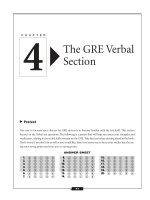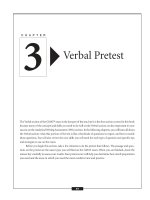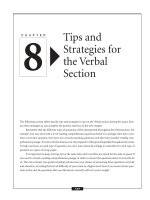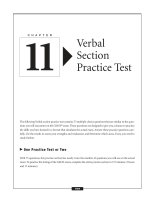Gre verbal section 5 pdf
Bạn đang xem bản rút gọn của tài liệu. Xem và tải ngay bản đầy đủ của tài liệu tại đây (75.96 KB, 6 trang )
that’s the one!” and move on without even looking at the other answers, including the correct one. Even if
you think you see the correct answer, look at all the answer choices before making your final selection.
When a question has two blanks, you may be able to figure out the answer to one blank but not the
other. If so, that’s good—you can now eliminate all answers that do not fit in that blank. Then you can
continue your efforts by focusing exclusively on the other blank.
How to Approach Reading Comprehension Questions
The Verbal section of the GRE contains at least two reading comprehension passages, each one followed by
questions about the passage. Passages are excerpted from writings in the fields of the humanities and the social
and natural sciences. Each prose passage is 300 to 1,000 words in length, and there will be several questions
(most likely four to seven questions) regarding each one.
The reading comprehension questions test your ability to understand what you read. You will often be
required to identify the author’s main point or purpose in writing the passage. You will also have to accurately
interpret secondary points and even the assumptions that underlie what is explicit in the passage. The ques-
tions will ask you to analyze each passage from several perspectives, including the kinds of research that might
confirm or negate the author’s conclusions.
GRE passages are usually complex and densely packed with ideas, and many are somewhat over-
whelming at first glance. You must be able to extract information, both expressed and implied. You will be
asked about the logical flow of the texts and about their consistency or lack thereof. You may also have to
answer questions about the tone of the passages as well as their overall theme or meaning. You will see phrases
such as the passage implies that . . . and the author suggests that . . . , which require you to extrapolate from the
information given to form your own conclusions.
Finding the Main Idea
Standardized reading comprehension tests always have questions about the main idea of the passage, and for
good reason: The main idea is the key concept or thought that the writer wants to convey in the text.
People often confuse the main idea of a passage with its topic, but they are two very different things. The
topic or subject of a passage is what the passage is about. The main idea, on the other hand, is what the writer
wants to say about that subject. For example, take a look at this paragraph:
Although many social policies and much legislation is founded on this “greatest good” phi-
losophy, there are several problems with utilitarianism as a basis for morality. First, happi-
ness is not so easy to quantify, and any measurement is bound to be subjective. Second, in a
theory that treats everything except happiness as instrumentally rather than intrinsically valu-
able, anything—or, more importantly, anyone—can (and should) be treated as a means to an
end, if it means greater happiness. This rejects the notion that human beings have their own
intrinsic value. Further, utilitarianism puts the burden of the happiness of the masses on the
suffering of the few. Is the happiness of many worth the suffering of a few? Why do those few
– THE GRE VERBAL SECTION–
110
deserve to suffer? Isn’t this burden of suffering morally irresponsible? This is the dilemma so
brilliantly illustrated in LeGuin’s story.
This paragraph is about “problems with utilitarianism,” but that does not adequately convey the main idea.
The main idea must say something more, make a specific assertion about that subject. And there are many
things we could say about this topic: “There are not any problems with utilitarianism,” for example, or “The
problems with utilitarianism are an acceptable tradeoff for happiness,” or “The problem with utilitarianism
is its mathematical approach to happiness.” In this paragraph, the writer makes his or her assertion (the main
point) in the first sentence:
Although many social policies and much legislation is founded on this “greatest good” phi-
losophy, there are several problems with utilitarianism as a basis for morality.
A sentence like this—one that clearly expresses the main idea of a paragraph—is the topic sentence.A
sentence that expresses the main idea of a longer text (an essay) is the thesis statement. Of course, main ideas
are not always stated in topic sentences or thesis statements, and in much of what you read, main ideas will
be inferred. We will deal with that scenario in a moment.
Whether explicit or implied, a main idea must be sufficiently general to hold together all of the ideas in
the passage. Indeed, everything in the passage should work to explain, illustrate, or otherwise support the main
idea. Thus, you can think of the main ideas as an umbrella that covers (encompasses) all of the other ideas in
the passage. For example, look at the following choices for the main idea of the utilitarianism paragraph:
a. Utilitarianism is problematic because it treats people as a means to an end.
b. Utilitarianism requires that a few suffer so that many can be happy.
c. Utilitarianism is flawed as a foundation for moral action.
d. Utilitarianism is often used to determine social policy.
e. Utilitarianism does not adequately respect minority rights.
The only answer that can be correct is choice c, because it is the only idea general enough to hold together
all of the information in the paragraph. Choices a, b, and e are all too specific to be the main idea; they are
not broad enough to cover all of the ideas in the passage, which discusses three different problems with util-
itarianism, including the problems cited in choices a, b, and e. Choice d is a contrasting idea used to intro-
duce the main idea of the sentence, and how utilitarianism is used to determine social policy is not even
discussed in this paragraph, so the idea expressed in choice d certainly does not hold together the entire
paragraph. Only choice c is general enough to cover every sentence in the paragraph. It makes an umbrella
statement that all of the sentences in the paragraph work to support.
Fortunately, the skills you are learning for the sentence completion questions will also serve you well
on the critical reading questions. Additionally, these critical reading and analysis skills will make your
post-graduate career even more successful.
– THE GRE VERBAL SECTION–
111
Topic/Subject: what the passage is about
Main Idea: the overall fact, feeling, or thought a writer wants to convey about his or her subject
112
Ready, Set, Read!
If you are already skilled at quickly reading and understanding dense prose, good for you! If not, try this
approach. Feel free to adapt it and change it to suit your needs and temperament. There’s no one right way
to read. The right way to do all of these things is the way that works for you; so as you practice, try variations
on the method to see what suits you. But do practice; it’s the only way to get better! In fact, you may want to
seek out your own difficult reading passages and practice writing questions about them.
First, try to skim the passage for its subject matter. With practice, you will find that topic sentences and
key adjectives will practically leap out and grab your attention. Be sure to keep your pencil poised to write
as you read. You will want to use your scratch paper to jot down key words and phrases as you see them. You
may think you will save time by not making notes, but that is not the case! Think of yourself as a spelunker,
exploring a dark cave. Your notes are your lifeline; they enable you to find your way back through the pas-
sage as you answer the questions. You don’t want to have to wander around in the cave; you need to know
what territory you have already covered, so you can stride purposefully back through it. Your notes save you
the wandering. They save you time.
Next, read the passage all the way through. As you finish each paragraph, ask yourself, “What was the
main idea?” Then jot down a word, phrase, or diagram that expresses that idea. This is a note for yourself,
one that will enable you to quickly tie the separate paragraphs into a coherent whole that will express the
theme or point of the passage.
Writers often provide clues that can help distinguish between main ideas and their support. The following
transitions are some of the most common words and phrases used to introduce specific supporting examples:
for example for instance in particular
in addition furthermore some
others specifically
Look for these transitions to help distinguish between main and supporting ideas.
As you read the passage, write down any words or phrases that seem particularly important or expres-
sive. Also note the line numbers in which they are found. Often, adjectives that set a mood or tone will help
you understand the author’s meaning, so jot them down as well. It’s equally important to make note of details
or pieces of evidence that support the author’s main point(s). These notes are for you, so make them only as
complete as you need them to be.
Don’t write more than you need to, but be sure you can make sense of what you write. It’s good to prac-
tice this technique before you actually need it.You can start with whatever you are reading, including this book.
Differentiating Topics from the Main Idea
If you encounter a word you don’t know, try to determine what the word means from its context.
■ Find the clues the author provides in the sentence and surrounding sentences.
■ Try to determine whether each clue word is positive or negative.
■ Mark the page or write down the word somewhere so you can look it up later. See how closely you were
able to guess its meaning.
The more you practice determining meaning from context, the more accurately you will be able to guess at those
meanings and understand material at test time.
Using Context
113
If you were paying attention in English class when the teacher discussed topic sentences, you know that
most well-written paragraphs have at least one sentence that sums up the main thrust of the paragraph. It is
most often either the first or the last sentence, so if you are having trouble determining the author’s point,
reread the first and last sentences of each paragraph. You can’t depend on that technique, though; use your
judgment to determine if either of these sentences is truly the topic sentence.
Once you have carefully but quickly read the entire passage,it’s time to tackle the questions.This is when
the notes you have jotted will come in handy. Whenever you see words and phrases from your notes in
the questions, you will know right where to look for them in the passage. You will want to cross-
reference the passage, the questions,and your notes in order to determine the one best answer to each question.
Whenever you see a word or phrase such as best, primarily, most closely, or most nearly, it alerts you to the likely
presence of particularly clever distracter answers. That is to say, two or more answers may be close contenders—that
both reflect language from the passage or are true about the passage. Rest assured, however, that with careful atten-
tion to the wording of both question and answer choices, you can determine which choice is truly best.
Making Inferences
Inferences are conclusions drawn based on evidence. For example, if you look up at the sky and see heavy black
clouds, you might logically infer that it is going to rain. Reading comprehension questions like those you will see
on the GRE will often ask you to draw conclusions based on what you read in the passage. The key to drawing
the right conclusions (making the right inferences) is the same as the key to finding the meaning of unfamiliar
vocabulary words. You have to look for clues in the context. These clues include details, actions, and ideas
described in the text (what has been stated, proposed, asked, or asserted), sentence structure, and word choice.
Making logical inferences is largely a matter of looking objectively at the evidence in the passage.
Remember, you are not being asked what you think about the writer or the passage but what is implied by
the passage. What do the ideas and words add up to? What does the evidence suggest? For example, take a
look at the description on the next page.
Types of Evidence
An author can support his or her argument with many types of evidence, including:
114
Dennis was scared. His knees were weak. He looked down . . . the water was twenty feet
below. He looked up again, quickly. He tried to think of something else. He tried to reassure
himself.“It’s only twenty feet!” he said aloud. But that only made it sound worse. Twenty feet!
The writer could have said, “Dennis was scared. He was afraid of heights.” Instead, the writer suggests
how Dennis feels through details (his knees were weak), repetition (twenty feet), and the short, choppy sen-
tence structure.
Word Choice
Often, the best clues to meaning come from the specific words a writer chooses to describe people, places, and
things. The writer’s word choice (also called diction) can reveal a great deal about how he or she feels about
the subject.
By looking closely at word choice, you will find clues that can help you better understand the text. Word
choice clues can come in the following forms:
■
particular words and phrases that the author uses
■
the way those words and phrases are arranged in sentences
■
word or sentence patterns that are repeated
■
important details about people, places, and things
To see how word choice reveals the writer’s attitude, read the two sentences below:
a. Higgins proposed a revolutionary idea.
b. Higgins proposed a radical idea.
It is not hard to see the difference between these sentences. In sentence a, the writer calls Higgins’s idea rev-
olutionary, while the writer of sentence b calls the idea radical. Though the sentences are similar, their word
choice conveys two very different attitudes about Higgins’s idea. Both writers agree that Higgins’s idea is
■ observations
■ interviews
■ surveys and questionnaires
■ experiments
■ personal experience
■ expert opinions
something unusual, different from the norm. But the way in which it is unusual differs significantly between
sentences. A revolutionary idea is unusual in that it is new and unlike ideas that came before; it changes things
dramatically. A radical idea, however, is unusual because it is extreme. From the word choice, we can infer that
the writer of sentence a feels very positive about Higgins’s proposal, while the writer of sentence b may feel
concerned about the extreme nature of Higgins’s plan. The writer doesn’t need to spell out his or her feel-
ings because the word choice makes his or her position clear.
DENOTATION AND
CONNOTATION
Even words that seem to mean the same thing have subtly different meanings and sometimes not-so-subtle
effects. For example, look at the words dangerous and perilous. If you say, “The situation is dangerous,” that
means one thing. If you say,“The situation is perilous,”that means something slightly different. That’s because
dangerous has a different connotation than perilous. Connotation is a word’s suggested or implied meaning;
it’s what the word makes you think or feel. Dangerous and perilous have nearly the same denotation or dic-
tionary definition—in fact, each word is used in the definition of the other. But perilous suggests more threat
of harm than dangerous suggests. Peril has a more ominous ring to it than danger has and suggests a more
life-threatening situation. Perilous and dangerous, then, have different connotations, and the word you choose
to describe the situation can tell others a lot.
EUPHEMISMS AND DYSPHEMISMS
Another way writers use word choice to reveal their feelings is through the use of euphemismsand dysphemisms.
A euphemism is a neutral or positive word used in place of something negative. A common example is to sub-
stitute the phrase passed on or departed for died.A dysphemism, on the other hand, uses a negative word or phrase
(instead of something neutral or positive), such as saying croaked or kicked the bucket for died. To cite a business
example,“I’ve been let go” is a euphemism and “I’ve been axed” is a dysphemism for “I’ve been fired.”
Seven Strategies for Reading Comprehension Questions
1. Read actively! As you read, ask yourself what each paragraph is about. Make notes about the passage;
react to it on your scratch paper. Be an engaged reader. Try to become interested for a few minutes in
the passage’s subject.
2. If you have an especially good short-term memory, you may want to look at the questions before you
read the passage. Jot down the words and phrases the questions ask about, then look for those words
and phrases in the passage. When you find them, you can either go ahead and answer the question
right then or note the area to come back to later.
3. If you don’t understand what a question is asking, rephrase the question using your own words. GRE
questions are written in a very precise, formal style in order to eliminate any ambiguity. Unfortunately,
nobody talks that way, so the questions can be confusing at first glance. Once you have noted the key
words and phrases, rewrite the question in a way that makes sense to you. Don’t be afraid to add new
words to the question; just be sure the words express the same ideas as the question, and don’t change
the meaning in any way.
– THE GRE VERBAL SECTION–
115









